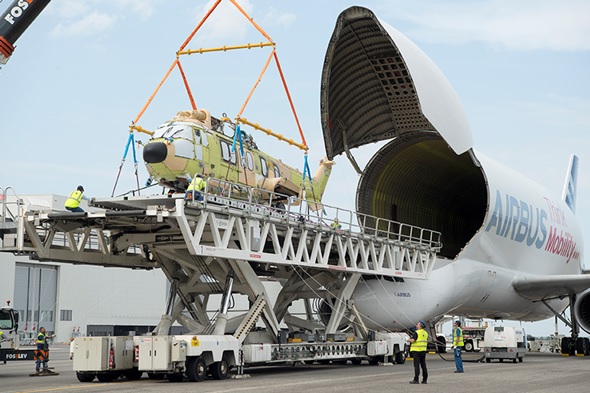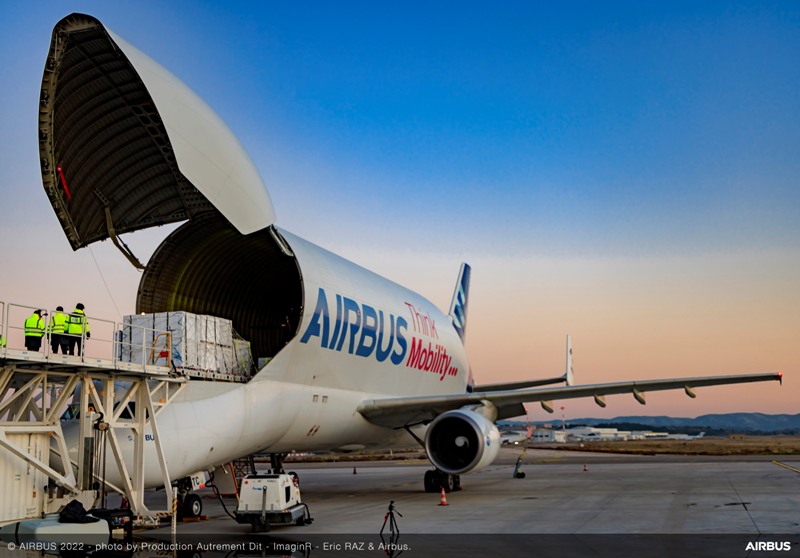Belugas make a splash as they hit the air cargo market
04 / 04 / 2022

Photo: Airbus S.A.S. H Gousse/ Master films
Airbus Beluga Transport enters the commercial market at a time when outsize capacity is at its tightest, with demand surging and the availability of the global AN-124 fleet curtailed, writes David Kershaw, editor of Air Cargo News’ sister title Heavy Lift and Project Forwarding International.
Based on the A300-600 design, the BelugaST cuts a startling silhouette. Airbus has used five of these models to transport its own aircraft sections and equipment between manufacturing facilities.
These are being replaced gradually by six new BelugaXLs based on the larger A330-200 platform.
“Going forward, we plan to gradually increase the BelugaST fleet for the new Airbus Beluga Transport service from one today to five in 2024. The average annual flights should increase from some 20 this year to more than 100 by 2024,” said Reza Fazlollahi, business development manager at Airbus Beluga Transport.
Initially, Airbus Customer Services will sell the capacity to the market, with ATI as operator. By 2023, a fully dedicated subsidiary will be created that will take over this service business.
According Fazlollahi, Airbus Beluga Transport is entering this market for the long haul, not as a short-term venture to address immediate capacity issues.
“The BelugaST provides freight forwarders and other potential customers with a new air transport solution for their outsized cargo that is not currently available in the market. Existing suppliers can offer payload weight capability, but none can compete with the Beluga on volume/cross-section dimensions,” he said.
A BelugaST has a maximum payload of 40 tonnes, but its unique selling point is the largest cross-section of any aircraft, with a cargo bay measuring 7.1 m high, 6.7 m wide and 39 m long – opening up new possibilities for shippers wanting to move large items by air.
“We are not a direct competitor with Antonov, we are complementary,” said Fazlollahi. Where the BelugaST is 50% higher and 10% wider than the AN-124, it loses out to the latter’s 150-tonne payload capacity.
Fazlollahi drew attention to the aircraft’s proven track record within the Airbus production network, as well as it being quieter and up 50% more fuel efficient than comparable freighter aircraft.
“It can land at more airports due to its shorter stopping distance,” he added. It has a range of 1,500 nm (2,780 km) with a 40-tonne payload, rising to 2,500 nm (4,630 km) with 26 tonnes stowed.
Typical industry sectors that could be served include engine manufacturers; space industries; helicopter manufacturers; aeronautic oil and gas and energy providers; maritime machinery manufacturers; military vehicles and humanitarian supply distributors.
Airbus Beluga Transport’s inaugural job took place at the end of December 2021, when BelugaST No3 delivered a new helicopter from Airbus Helicopters’ manufacturing site in Marignane, France, to Kobe in Japan.
The aircraft stopped to refuel at various transit points – including Warsaw (Poland), Novosibirsk (Russia) and Seoul (South Korea). Notably, the whole helicopter could be accommodated inside the Beluga without any prior disassembly – only needing its long rotor blades to be folded back.
Loading platform
The BelugaST features a nose-loading door situated above the cockpit and items require special means of loading, depending on their size and weight.
From May 2022, an onboard cargo loader (OBCL) will be installed.
“The platform will fly inside the aircraft with the payloads and will allow greater autonomy and reactivity. It will be handled by a loading technical expert (Airbus Load Master) for both the loading and unloading phase,” said Fazlollahi.
This will be able to handle loads up to 20 tonnes up to 12 m in length; Airbus Beluga Transport expects two-thirds of its missions to mobilise the OBCL.
Present means of loading include a multipurpose pallet, which creates an ‘artificial floor’ inside the Beluga on which the payloads are situated.
Otherwise, outboard platforms are dispatched prior to the departure/arrival of the BelugaST, allowing for loading/discharge by means of a truck crane; this outboard platform interfaces with the aircraft at a height of 5 m and is rolled into the hold.
“Several outboard platforms will be located at different places in the world to allow quick shipment and installation before the aircraft arrival,” Fazlollahi explained.
The heavy lift and project shipping industry has long been concerned about a lack of outsize airfreight capacity. Boeing 747 production is set to close this year with the delivery of four B747-8 freighters to Atlas Air, and there is no sign of a new airframe that features nose-loading capability.
Antonov’s AN-225 Mriya, the world’s largest cargo aircraft, was destroyed in February by Russian forces in Ukraine.
Globally, just 35 AN-124 aircraft are in service or storage. Volga-Dnepr operates 12 and Russia’s air force owns/operates 13, according to Cirium fleet data. Ukrainian company Antonov Airlines has another seven.
The introduction of five BelguaSTs to the commercial market will be welcomed by the industry and could become an eye-catching feature of the skies for many years to come.
“The first BelugaST entered into service in 1996 and the last one was delivered in 2001. The BelugaSTs are at 50 percent of their life with 15,000 cycles already done. The design service goal is 30,000 cycles,” he said.















